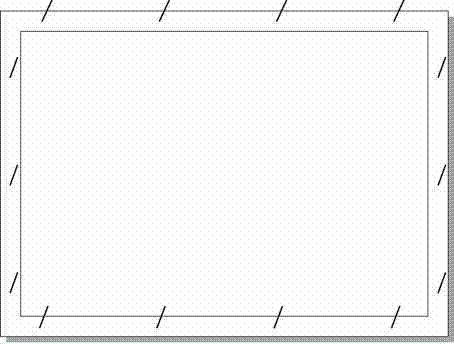Mold for preparing accellular small intestine submucosa matrix material
A technology for the submucosa and matrix material of the small intestine, applied in the field of medical biomaterials, can solve the problems of affecting the porosity of the material and destroying the three-dimensional structure, and achieve the effect of ensuring the porosity
- Summary
- Abstract
- Description
- Claims
- Application Information
AI Technical Summary
Problems solved by technology
Method used
Image
Examples
Embodiment 1
[0020] The mold used for preparing the matrix material of the decellularized small intestine submucosa in this example consists of two parts: a negative sheet and a pressing net. Described bottom film is the square plate that pin is provided with on four sides, and described pin is perpendicular to square plate, as figure 1 shown. The press net is a square frame with a square frame structure or a mesh structure inside, and the four side lengths of the press net are all 1-3 cm shorter than the negative film. The unit shapes of the network structure include square, rhombus and circle. The frame structure pressing net is as figure 2 As shown, the mesh structure pressing net is as image 3 shown (shown as a rhombus). The height of the needles is 0.5-1.5 cm, the diameter is 0.5-2.0 mm, and the distance between the needles is 0.5-2 cm. There is welding between the needle and the square plate. The negative, the needle on the negative, and the pressing net are all made of 316L ...
Embodiment 2
[0022] The porosity of the decellularized porcine small intestinal submucosa matrix material prepared by using the mold provided in Example 1 was measured by mercury intrusion porosimetry, and compared with the product of Biodesign Surgisis. Results: The porosity of the acellular porcine small intestinal submucosa matrix material prepared by the mold provided in Example 1 was 87.8±2.51, and the porosity of the Biodesign Surgisis product was 78.3±6.38.
PUM
| Property | Measurement | Unit |
|---|---|---|
| height | aaaaa | aaaaa |
| diameter | aaaaa | aaaaa |
| porosity | aaaaa | aaaaa |
Abstract
Description
Claims
Application Information
 Login to View More
Login to View More - R&D
- Intellectual Property
- Life Sciences
- Materials
- Tech Scout
- Unparalleled Data Quality
- Higher Quality Content
- 60% Fewer Hallucinations
Browse by: Latest US Patents, China's latest patents, Technical Efficacy Thesaurus, Application Domain, Technology Topic, Popular Technical Reports.
© 2025 PatSnap. All rights reserved.Legal|Privacy policy|Modern Slavery Act Transparency Statement|Sitemap|About US| Contact US: help@patsnap.com



